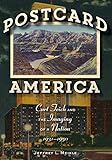Postcard America : Curt Teich and the Imaging of a Nation, 1931-1950 / Jeffrey L. Meikle.
Material type: TextPublisher: Austin : University of Texas Press, [2021]Copyright date: ©2016Description: 1 online resourceContent type:
TextPublisher: Austin : University of Texas Press, [2021]Copyright date: ©2016Description: 1 online resourceContent type: - 9781477308592
- 972/.530831
- NC1875.U6 T456 2015
- F1386.4.T597S74 2016
- online - DeGruyter
| Item type | Current library | Call number | URL | Status | Notes | Barcode | |
|---|---|---|---|---|---|---|---|
 eBook
eBook
|
Biblioteca "Angelicum" Pont. Univ. S.Tommaso d'Aquino Nuvola online | online - DeGruyter (Browse shelf(Opens below)) | Online access | Not for loan (Accesso limitato) | Accesso per gli utenti autorizzati / Access for authorized users | (dgr)9781477308592 |
Frontmatter -- Contents -- Acknowledgments -- 1. “They Do Say It’s Real”: An Introduction to Linen Postcards -- 2. Curt Teich and the Early History of Postcards -- 3. The Linen Postcard: Innovation and Aesthetics -- 4. Landscapes in Linen Postcards: A National Imaginary -- Portfolio 1: Landscapes -- Representative Vistas -- The Southwest: A Regional Aesthetic -- Travel and Tourism -- Scenic People -- Resources -- Infrastructure and Transportation -- 5. Cityscapes in Linen Postcards: Images of Modernity -- Portfolio 11: Cityscapes -- Overviews -- Skyscrapers -- Main Streets -- Landmarks -- Recreation -- World’s Fairs -- Accommodations -- 6. From a Rearview Mirror: Contemporary Reflections -- Notes -- Illustration Credits -- Index
restricted access online access with authorization star
http://purl.org/coar/access_right/c_16ec
From the Great Depression through the early postwar years, any postcard sent in America was more than likely a “linen” card. Colorized in vivid, often exaggerated hues and printed on card stock embossed with a linen-like texture, linen postcards celebrated the American scene with views of majestic landscapes, modern cityscapes, roadside attractions, and other notable features. These colorful images portrayed the United States as shimmering with promise, quite unlike the black-and-white worlds of documentary photography or Life magazine. Linen postcards were enormously popular, with close to a billion printed and sold. Postcard America offers the first comprehensive study of these cards and their cultural significance. Drawing on the production files of Curt Teich & Co. of Chicago, the originator of linen postcards, Jeffrey L. Meikle reveals how photographic views were transformed into colorized postcard images, often by means of manipulation—adding and deleting details or collaging bits and pieces from several photos. He presents two extensive portfolios of postcards—landscapes and cityscapes—that comprise a representative iconography of linen postcard views. For each image, Meikle explains the postcard’s subject, describes aspects of its production, and places it in social and cultural contexts. In the concluding chapter, he shifts from historical interpretation to a contemporary viewpoint, considering nostalgia as a motive for collectors and others who are fascinated today by these striking images.
Mode of access: Internet via World Wide Web.
In English.
Description based on online resource; title from PDF title page (publisher's Web site, viewed 27. Okt 2021)


